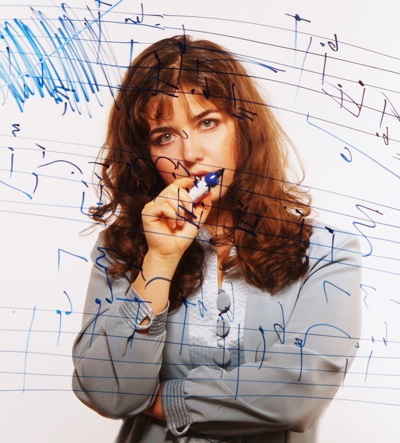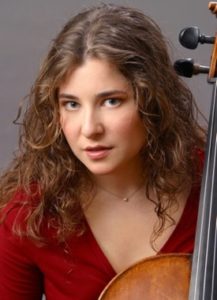Herbst Theater spellbound

Hot young composer Lera Auerbach joined Alisa Weilerstein, arguably the next generation’s great cellist, in a program that explored Bach through the lens of Shostakovich, and then re-imagined it for piano and cello. This layering of composers revealed the past in the motives of the present through the smoked glass and mirrors of modern modes and long reflection.
Shostakovich wrote his 24 Preludes over two months in 1932 when he was just 26, sourcing Bach’s famous 24 Preludes and Fugues from the Well-Tempered Clavier. Gestural and sarcastic, these brief “poems” departed from Bach’s delicacy to paint portraits of Russian society, from the drunken brass band to the pompous bureaucrat. In 1951 Shostakovich wrote another set, the 24 Preludes and Fugues, op. 87, and that set is gentler and better known. While musically more adventurous, his later work is politically subtle.
His earlier Preludes marked the end of a more outspoken period in the composer’s life, after which he was denounced for “formalism,” forcing the composer to couch his political views in careful musical codes.
Auerbach spoke to us before sitting down at the piano to accompany Weilerstein. “The preludes are bursting with humor, but that humor is sarcastic. He refers to brass band. More often than not the musicians in these bands were drunk, playing more than is written…They are brilliant portraits of Shostakovich’s time.”
Auerbach’s rearrangement of those Preludes to include cello premiered last year in Germany. Weilerstein began with sharp plucks, mock-serious notes that set a rude tone. Auerbach entered with a delicacy in the piano which is child-like yet distant, and the cello returned thick chords and a final slide of whimsy. The cello seemed to traverse from low gravel to high whine while skipping any hint of compassion.
The second prelude, like tango, is abrupt and delicious.
The third finds its lyric center, heartfelt folksong, thick with double stops, and a last attack.
For those unfamiliar with the language of repression, Auerbach’s arrangement helped bring out the underlying bite and translated Shostakovich’s motives into dialog. Her transcriptions are simply brilliant.

More moods followed: a Bach-inspired fugue with earthy cello and delicately traced piano notes, rising to a stunning release. Then came a prelude both regal and mocking, dissonant double stops and scrubbed bowing, clownish cello and circus piano. We later heard those brass bands lurching on, and bitter winds of winter, and mocking waltz.
Auerbach’s language was very different. “I wrote them for piano 11 years ago, in 1999,” she said, as she introduced her own preludes on the second half of the program. “I enjoyed writing them so much that I was very sad when I finished. So I wrote 24 more for piano and violin. And then for piano and cello—72 preludes in one year! It was somewhat obsessive.” Originally written for ballet, she reworked it for concert. “One large structure, but each prelude is a poem, a duality of large and small.”
Auerbach maintains an overarching feel despite the slippery changes of style, perhaps because along with pianistic fireworks are passages of great lyricism.
Sensual chromaticism, a cat-like stretch and glide up half steps is followed by a stunning burst of speed. Cello slides and the nasal sound of erhu show off Auerbach’s larger instrumental vocabulary, but she uses it compellingly. Auerbach’s portraits are deft, with little of Shostakovich’s bitterness.
And that overall vision? Bach’s luminosity shines from within both later composers, an august lineage.
—Adam Broner
Originally published in the Piedmont Post.
Photo top: composer and pianist Lera Auerbach, photo by F. Reinhold. Photo bottom: cellist Alisa Weilerstein, photo by Christian Steiner.
